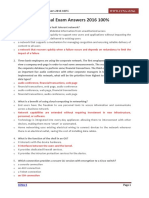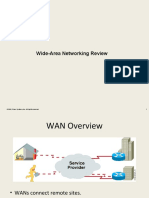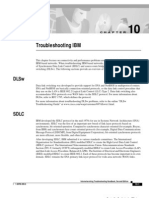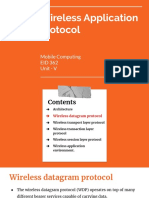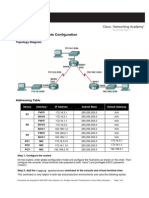Frame Relay Tutorial: Go To Comments
Frame Relay Tutorial: Go To Comments
Uploaded by
Amro GoneimCopyright:
Available Formats
Frame Relay Tutorial: Go To Comments
Frame Relay Tutorial: Go To Comments
Uploaded by
Amro GoneimOriginal Title
Copyright
Available Formats
Share this document
Did you find this document useful?
Is this content inappropriate?
Copyright:
Available Formats
Frame Relay Tutorial: Go To Comments
Frame Relay Tutorial: Go To Comments
Uploaded by
Amro GoneimCopyright:
Available Formats
CCNA Training Frame Relay Tutorial
Type text to search here...
Page 1 of 8
Submit Query
Home > Frame Relay Tutorial
Frame Relay Tutorial
September 7th, 2011 Go to comments
In the last part we will mainly learn about LMI, which is the signaling protocol of Frame Relay
LMI
Local Management Interface (LMI) is a signaling standard protocol used between your router (DTE) and
the first Frame Relay switch. The LMI is responsible for managing the connection and maintaining the
status of your PVC.
LMI includes:
+ A keepalive mechanism, which verifies that data is flowing
+ A multicast mechanism, which provides the network server (router) with its local DLCI.
+ A status mechanism, which provides PVC statuses on the DLCIs known to the switch
In our example, when HeadQuarter is configured with Frame Relay, it sends an LMI Status Inquiry
message to the DCE. The response from the DCE might be a small Hello message or a full status report
about the PVCs in use containing details of all the VCs configured (DLCI 23 & 51). By default, LMI
messages are sent out every 10 seconds.
The four possible PVC states are as follows:
+ Active state: Indicates that the connection is active and that routers can exchange data.
+ Inactive state: Indicates that the local connection to the Frame Relay switch is working, but the
remote router connection to the Frame Relay switch is not working.
+ Deleted state: Indicates that no LMI is being received from the Frame Relay switch, or that there is no
service between the customer router and Frame Relay switch.
http://www.9tut.com/frame-relay-tutorial/3
12/15/2015
CCNA Training Frame Relay Tutorial
Page 2 of 8
+ Static state: the Local Management Interface (LMI) mechanism on the interface is disabled (by using
the no keepalive command). This status is rarely seen so it is ignored in some books.
We can use the show frame-relay lmi to display LMI statistics of Frame Relay on enabled interfaces
of the router. The output shows the LMI type used by the Frame Relay interface and the counters for the
LMI status exchange sequence, including errors such as LMI timeouts.
Cisco routers support the following three LMI types:
* Cisco: LMI type de?ned jointly by Cisco, StrataCom, Northern Telecom (Nortel), and Digital
Equipment Corporation
* ANSI: ANSI T1.617 Annex D
* Q.933A: ITU-T Q.933 Annex A
Notice that three types of LMI are not compatible with each others so the LMI type must match between
the provider Frame Relay switch and the customer DTE device.
From Cisco IOS Release 11.2, the router attempts to automatically detect the type of LMI used by the
provider switch.
Note: LMI is required for Inverse ARP to function because it needs to know that the PVC is up before
sending out Inverse ARP Request.
Now you learn most of Frame Relay mentioned in CCNA, some other Frame Relays characteristics you
should know are mentioned below.
Other Frame Relay characteristics
+ Frame Relay provides no error recovery mechanism. It only provides CRC error detection.
+ Unlike with LANs, you cannot send a data link layer broadcast over Frame Relay. Therefore, Frame
Relay networks are called nonbroadcast multiaccess (NBMA) networks.
+ Depending on the bandwidth needed for each virtual connection, the customer can order a circuit with
a guaranteed amount of bandwidth. This amount is the Committed Information Rate (CIR). CIR
defines how much bandwidth the customer is guaranteed during normal network operation. Any data
transmitted above this purchased rate (CIR) is available for discard by the network if the network
doesnt have available bandwidth.
+ If the Frame relay switch begins to experience congestion, it sends the upstream site (to the source) a
Backward explicit congestion notification (BECN) and the downstream site (to the destination) a
Forward explicit congestion notification (FECN).
http://www.9tut.com/frame-relay-tutorial/3
12/15/2015
CCNA Training Frame Relay Tutorial
Page 3 of 8
+ There are two Frame Relay encapsulation types: the Cisco encapsulation and the IETF Frame Relay
encapsulation, which is in conformance with RFC 1490 and RFC 2427. The former is often used to
connect two Cisco routers while the latter is used to connect a Cisco router to a non-Cisco router.
+ Frame Relay does not define the way the data is transmitted within the service providers network
once the traffic reaches the providers switch. So the providers can use Frame Relay, ATM or PPP
inside their networks.
Layer 2 Encapsulation Protocols
Besides Frame Relay there are other Layer 2 Encapsulation Protocols that you can implement instead:
High-Level Data Link Control (HDLC): The default encapsulation type for Cisco routers on point-topoint dedicated links and circuit-switched connections. HDLC is a Cisco proprietary protocol.
Point-to-Point Protocol (PPP): Provides connections between devices over several types of physical
interfaces, such as asynchronous serial, High-Speed Serial Interface (HSS1), ISDN, and synchronous.
PPP works with many network layer protocols, including IP and IPX. PPP can use either Password
Authentication Protocol (PAP) or Challenge Handshake Authentication Protocol (CHAP) for
authentication.
X.25/Link Access Procedure, Balanced (LAPB): Defines connections between DTE and DCE for
remote terminal access. LAPB is a data link layer protocol specified by X.25.
Asynchronous Transfer Mode (ATM): International standard for cell relay using fixed-length (53byte) cells for multiple service types. Fixed-length cells allow hardware processing, which greatly
reduces transit delays. ATM takes advantage of high-speed transmission media such as E3, T3, and
Synchronous Optical Network (SONET).
If you want to learn how to configure Frame Relay in GNS3, please read my Frame Relay Lab in GNS3
tutorial.
Pages: 1 2 3
Comments (165) Comments
http://www.9tut.com/frame-relay-tutorial/3
12/15/2015
CCNA Training Frame Relay Tutorial
Page 4 of 8
Comment pages
Previous 1 2 3 4 817
1. Anonymous
June 16th, 2015
thanks so much
2. rahul
June 17th, 2015
Nice Explanation.. Thanks a lot !!
3. nghia
July 2nd, 2015
Thanks so much.
4. Scrotum
July 4th, 2015
I think there is an error with the statement on that lecture
if Branch 1 sends an update to HeadQuarter then HeadQuarter cant send that update to Branch 2
because they are received and sent on the same interface.
shouldnt it be if Branch 1 sends an update to Headquareter than Headquarter cant send that
update to Branch 1 (not Branch 2)?
5. Satya
July 16th, 2015
Hi, most of the data is not suffering to understand the topic,
and always it is changing, but it is information is good
Thanks
Satya
6. pankaj jaiswal
July 22nd, 2015
thanks so much
7. shayan
July 29th, 2015
thank you for your share
8. Anonymous
http://www.9tut.com/frame-relay-tutorial/3
12/15/2015
CCNA Training Frame Relay Tutorial
Page 5 of 8
September 13th, 2015
thank u
9. Phil
September 21st, 2015
Thanks so much for sharing this information
10. Mark Wallis
October 13th, 2015
HDLC is not Cisco proprietary but their implementation of it is because it adds an 8 bit type
field to the header. Thanks for the tutorials.
11. eliz
November 4th, 2015
thanks a lot
12. Ali
November 6th, 2015
Scrotum
the statement is correct because Head Quarter is connected to the FR cloud via one interface. If it
receives the update from Branch 1 then wouldnt it need to use the same int to send update to
Branch 2?
13. Ali
November 6th, 2015
@Mark Wallis
HDLC has always been and is Cisco proprietary protocol. here is the ref
https://supportforums.cisco.com/discussion/11637176/ppp-over-hdlc
14. Nigga
December 4th, 2015
There is only to say the word called Thank & You
15. renny
December 8th, 2015
thank you
Comment pages
Previous 1 2 3 4 817
http://www.9tut.com/frame-relay-tutorial/3
12/15/2015
CCNA Training Frame Relay Tutorial
Page 6 of 8
Add a Comment
Name
Submit Comment
Subscribe to comments feed
Subnetting Tutorial Subnetting Made Easy Wireless Tutorial
Premium Membership
Become a member to interact with all questions and read all tutorials, labs!
Find out more or Sign In
CCNA 200-120
z
z
z
z
z
z
z
z
z
z
z
z
z
z
z
z
z
CCNA Lab Sim
CCNA Basic Questions
CCNA OSI & TCP/IP Model
CCNA IOS Questions
CCNA WAN Questions
CCNA Switch Questions
CCNA Switch Questions 2
CCNA VLAN Questions
CCNA Trunking Questions
CCNA Trunking Questions 2
CCNA EtherChannel
CCNA InterVLAN Questions
CCNA STP
CCNA STP 2
CCNA RSTP
CCNA Access list Questions
CCNA Subnetting
http://www.9tut.com/frame-relay-tutorial/3
12/15/2015
CCNA Training Frame Relay Tutorial
z
z
z
z
z
z
z
z
z
z
z
z
z
z
z
z
z
z
z
z
z
z
z
z
z
z
z
z
Page 7 of 8
CCNA Subnetting 2
CCNA IP Routing Questions
CCNA IP Routing 2
CCNA Frame Relay
CCNA Frame Relay 2
CCNA NAT PAT Questions
CCNA OSPF Questions
CCNA OSPF Questions 2
CCNA EIGRP Questions
CCNA DHCP Questions
CCNA HSRP VRRP GLBP
CCNA SNMP Questions
CCNA NetFlow Questions
CCNA Syslog Questions
CCNA Security Questions
CCNA Operation Questions
CCNA Operation 2
CCNA Show commands
CCNA Troubleshooting
CCNA IPv6
CCNA IPv6 Questions 2
CCNA Drag and Drop 1
CCNA Drag and Drop 2
CCNA Drag and Drop 3
CCNA Drag and Drop 4
CCNA Drag and Drop 5
CCNA FAQs & Tips
Share your CCNA Experience
CCNA Self-Study
z
z
z
Practice CCNA GNS3 Labs
CCNA Knowledge
CCNA Lab Challenges
Network Resources
z
Free Router Simulators
ICND1/ICND2 Website
CCNP - ROUTE Website
CCNP - SWITCH Website
CCNP - TSHOOT Website
http://www.9tut.com/frame-relay-tutorial/3
12/15/2015
CCNA Training Frame Relay Tutorial
CCNA Security Website
CCNA Voice Website
CCNA Wireless Website
CCIE Website
Page 8 of 8
Top
Copyright 2010-2013 CCNA Training
Site Privacy Policy. Valid XHTML 1.1 and CSS 3.BH
http://www.9tut.com/frame-relay-tutorial/3
12/15/2015
You might also like
- Barracuda CloudGen Firewall Foundation Student Guide Rev2.0No ratings yetBarracuda CloudGen Firewall Foundation Student Guide Rev2.0133 pages
- NSE 4 6.4 Sample Questions - Attempt Review 2100% (2)NSE 4 6.4 Sample Questions - Attempt Review 210 pages
- Cisco CCNA Command Guide: An Introductory Guide for CCNA & Computer Networking Beginners: Computer Networking, #3From EverandCisco CCNA Command Guide: An Introductory Guide for CCNA & Computer Networking Beginners: Computer Networking, #34/5 (1)
- WAN TECHNOLOGY FRAME-RELAY: An Expert's Handbook of Navigating Frame Relay NetworksFrom EverandWAN TECHNOLOGY FRAME-RELAY: An Expert's Handbook of Navigating Frame Relay NetworksNo ratings yet
- Any Transport Over Multiprotocol: Cisco Label SwitchingNo ratings yetAny Transport Over Multiprotocol: Cisco Label Switching4 pages
- CCNA4 Final G (Sep 2009) : I Will Post Img LetterNo ratings yetCCNA4 Final G (Sep 2009) : I Will Post Img Letter13 pages
- Frame Relay and ATM: Version 1 ECE, IIT KharagpurNo ratings yetFrame Relay and ATM: Version 1 ECE, IIT Kharagpur8 pages
- 43 CCNA (200-120) Quick Notes Before Exam Sysnet NotesNo ratings yet43 CCNA (200-120) Quick Notes Before Exam Sysnet Notes16 pages
- Take Assessment CCNP BCMSN Final 3: (Version 5.0)100% (2)Take Assessment CCNP BCMSN Final 3: (Version 5.0)14 pages
- Frame Relay: Accessing The WAN - Chapter 3No ratings yetFrame Relay: Accessing The WAN - Chapter 338 pages
- Take Assessment - Dcompntwk Chapter 8 - Ccna Discovery: Designing and Supporting Computer Networks (Version 4.0) - Answers - 2012 - 2013No ratings yetTake Assessment - Dcompntwk Chapter 8 - Ccna Discovery: Designing and Supporting Computer Networks (Version 4.0) - Answers - 2012 - 20138 pages
- Sysnet Notes: Basic CCNA Interview Questions AND AnswersNo ratings yetSysnet Notes: Basic CCNA Interview Questions AND Answers8 pages
- Configuring and Troubleshooting Frame-RelayNo ratings yetConfiguring and Troubleshooting Frame-Relay73 pages
- ESwitching CCNA 3 Final 2013 - 2014 Exam Answers 100% – Full - LAN Switching and Wireless (Version 4.0) « QCrack.Com - i learning - CCNA Exploration 4.0, CCNA 640-802, CCNA Exam Final Answers, CCNA Blog100% (1)ESwitching CCNA 3 Final 2013 - 2014 Exam Answers 100% – Full - LAN Switching and Wireless (Version 4.0) « QCrack.Com - i learning - CCNA Exploration 4.0, CCNA 640-802, CCNA Exam Final Answers, CCNA Blog35 pages
- Troubleshooting IBM: Internetworking Troubleshooting Handbook, Second Edition 1-58705-005-6No ratings yetTroubleshooting IBM: Internetworking Troubleshooting Handbook, Second Edition 1-58705-005-654 pages
- Frame Relay: CCNA 4 Version 3.0 Rick Graziani Cabrillo CollegeNo ratings yetFrame Relay: CCNA 4 Version 3.0 Rick Graziani Cabrillo College94 pages
- Frame Relay: Accessing The WAN - Chapter 3 Sandra Coleman, CCNA, CCAINo ratings yetFrame Relay: Accessing The WAN - Chapter 3 Sandra Coleman, CCNA, CCAI38 pages
- NN - LAN Troubleshooting and Base LiningNo ratings yetNN - LAN Troubleshooting and Base Lining20 pages
- Introduction To Networks Version 70 ITNv7 Practice Final Exam AnswersNo ratings yetIntroduction To Networks Version 70 ITNv7 Practice Final Exam Answers27 pages
- Cisco Certified Network Associate (CCNA) and Cisco Certified Network Professional (CCNP): Mastering Network Automation and Programmability Study GuideFrom EverandCisco Certified Network Associate (CCNA) and Cisco Certified Network Professional (CCNP): Mastering Network Automation and Programmability Study GuideNo ratings yet
- Cisco Network Administration Interview Questions: CISCO CCNA Certification ReviewFrom EverandCisco Network Administration Interview Questions: CISCO CCNA Certification Review4.5/5 (6)
- CompTIA Network+ (N10-009) Study Guide: Comprehensive Exam Preparation and Key Concepts for Network ProfessionalsFrom EverandCompTIA Network+ (N10-009) Study Guide: Comprehensive Exam Preparation and Key Concepts for Network ProfessionalsNo ratings yet
- CISCO PACKET TRACER LABS: Best practice of configuring or troubleshooting NetworkFrom EverandCISCO PACKET TRACER LABS: Best practice of configuring or troubleshooting NetworkNo ratings yet
- LEARN MPLS FROM SCRATCH PART-A: A Beginner's Guide to Next Level of NetworkingFrom EverandLEARN MPLS FROM SCRATCH PART-A: A Beginner's Guide to Next Level of NetworkingNo ratings yet
- Alcatel-Lucent Service Routing Architect (SRA) Self-Study Guide: Preparing for the BGP, VPRN and Multicast ExamsFrom EverandAlcatel-Lucent Service Routing Architect (SRA) Self-Study Guide: Preparing for the BGP, VPRN and Multicast ExamsNo ratings yet
- TCP/IP: Network+ Protocols And Campus LAN Switching FundamentalsFrom EverandTCP/IP: Network+ Protocols And Campus LAN Switching FundamentalsNo ratings yet
- CompTIA A+ Complete Review Guide: Core 1 Exam 220-1101 and Core 2 Exam 220-1102From EverandCompTIA A+ Complete Review Guide: Core 1 Exam 220-1101 and Core 2 Exam 220-11025/5 (2)
- Table 5.2.1.1.1/2: Update Location Answer: ETSI TS 129 272 V9.13.0 (2014-07) 14 3GPP TS 29.272 Version 9.13.0 Release 9No ratings yetTable 5.2.1.1.1/2: Update Location Answer: ETSI TS 129 272 V9.13.0 (2014-07) 14 3GPP TS 29.272 Version 9.13.0 Release 91 page
- ETSI TS 129 272 V9.13.0 (2014-07) 22 3GPP TS 29.272 Version 9.13.0 Release 9No ratings yetETSI TS 129 272 V9.13.0 (2014-07) 22 3GPP TS 29.272 Version 9.13.0 Release 91 page
- 5.2.2 Subscriber Data Handling Procedures: 5.2.1.3.3 Detailed Behaviour of HSSNo ratings yet5.2.2 Subscriber Data Handling Procedures: 5.2.1.3.3 Detailed Behaviour of HSS1 page
- ETSI TS 129 272 V9.13.0 (2014-07) 23 3GPP TS 29.272 Version 9.13.0 Release 9No ratings yetETSI TS 129 272 V9.13.0 (2014-07) 23 3GPP TS 29.272 Version 9.13.0 Release 91 page
- Table 5.2.2.1.1/1: Insert Subscriber Data RequestNo ratings yetTable 5.2.2.1.1/1: Insert Subscriber Data Request1 page
- 5.2 Mobility Services: 5.2.1 Location Management ProceduresNo ratings yet5.2 Mobility Services: 5.2.1 Location Management Procedures1 page
- ETSI TS 129 272 V9.13.0 (2014-07) 15 3GPP TS 29.272 Version 9.13.0 Release 9No ratings yetETSI TS 129 272 V9.13.0 (2014-07) 15 3GPP TS 29.272 Version 9.13.0 Release 91 page
- Table 5.2.1.1.1/1: Update Location Request: ETSI TS 129 272 V9.13.0 (2014-07) 13 3GPP TS 29.272 Version 9.13.0 Release 9No ratings yetTable 5.2.1.1.1/1: Update Location Request: ETSI TS 129 272 V9.13.0 (2014-07) 13 3GPP TS 29.272 Version 9.13.0 Release 91 page
- ETSI TS 129 272 V9.13.0 (2014-07) 10 3GPP TS 29.272 Version 9.13.0 Release 9No ratings yetETSI TS 129 272 V9.13.0 (2014-07) 10 3GPP TS 29.272 Version 9.13.0 Release 91 page
- 7 Protocol Specification and Implementation ........................................................................................... 37No ratings yet7 Protocol Specification and Implementation ........................................................................................... 371 page
- ETSI TS 129 272 V9.13.0 (2014-07) 5 3GPP TS 29.272 Version 9.13.0 Release 9No ratings yetETSI TS 129 272 V9.13.0 (2014-07) 5 3GPP TS 29.272 Version 9.13.0 Release 91 page
- ETSI TS 129 272 V9.13.0 (2014-07) 3 3GPP TS 29.272 Version 9.13.0 Release 9No ratings yetETSI TS 129 272 V9.13.0 (2014-07) 3 3GPP TS 29.272 Version 9.13.0 Release 91 page
- ETSI TS 129 272 V9.13.0 (2014-07) 1 3GPP TS 29.272 Version 9.13.0 Release 9No ratings yetETSI TS 129 272 V9.13.0 (2014-07) 1 3GPP TS 29.272 Version 9.13.0 Release 91 page
- ETSI TS 129 272: Technical SpecificationNo ratings yetETSI TS 129 272: Technical Specification1 page
- GSM/GPRS Network GSM/GPRS Network Architecture Architecture: Radio Access Network BSSNo ratings yetGSM/GPRS Network GSM/GPRS Network Architecture Architecture: Radio Access Network BSS1 page
- UMTS Network Planning Optimization and Inter Operation With GSM - p26No ratings yetUMTS Network Planning Optimization and Inter Operation With GSM - p261 page
- UMTS Network Planning Optimization and Inter Operation With GSM - p11No ratings yetUMTS Network Planning Optimization and Inter Operation With GSM - p111 page
- CCNA 2 Chapter 4 v5.0 Exam Answers 2015 100No ratings yetCCNA 2 Chapter 4 v5.0 Exam Answers 2015 1008 pages
- Product Overview: USR-W610 Datasheet Technical SupportNo ratings yetProduct Overview: USR-W610 Datasheet Technical Support4 pages
- Scenario Lab IP Addressing On Catalyst 2950 SwitchesNo ratings yetScenario Lab IP Addressing On Catalyst 2950 Switches4 pages
- 6.3.1.2 Packet Tracer - Layer 2 SecurityNo ratings yet6.3.1.2 Packet Tracer - Layer 2 Security4 pages
- 7.1.2.9 Lab - Converting IPv4 Addresses To BinaryNo ratings yet7.1.2.9 Lab - Converting IPv4 Addresses To Binary6 pages
- 4.3RISE PCE CAA Connectivity - Options - Wave4No ratings yet4.3RISE PCE CAA Connectivity - Options - Wave417 pages
- N301V2.0-TDE01-Restore Configurations Using TpUpgrade User GuideNo ratings yetN301V2.0-TDE01-Restore Configurations Using TpUpgrade User Guide10 pages
- Xclarity Controller Standard, Advanced, and Enterprise Level FeaturesNo ratings yetXclarity Controller Standard, Advanced, and Enterprise Level Features4 pages
- Data Communications and Networking 3: Dashboard MIS6314 Week 4: Link Aggregation Short Quiz 003No ratings yetData Communications and Networking 3: Dashboard MIS6314 Week 4: Link Aggregation Short Quiz 0035 pages
- Lab: Basic Static Route Configuration: Topology DiagramNo ratings yetLab: Basic Static Route Configuration: Topology Diagram6 pages
- Barracuda CloudGen Firewall Foundation Student Guide Rev2.0Barracuda CloudGen Firewall Foundation Student Guide Rev2.0
- Cisco CCNA Command Guide: An Introductory Guide for CCNA & Computer Networking Beginners: Computer Networking, #3From EverandCisco CCNA Command Guide: An Introductory Guide for CCNA & Computer Networking Beginners: Computer Networking, #3
- WAN TECHNOLOGY FRAME-RELAY: An Expert's Handbook of Navigating Frame Relay NetworksFrom EverandWAN TECHNOLOGY FRAME-RELAY: An Expert's Handbook of Navigating Frame Relay Networks
- Any Transport Over Multiprotocol: Cisco Label SwitchingAny Transport Over Multiprotocol: Cisco Label Switching
- 43 CCNA (200-120) Quick Notes Before Exam Sysnet Notes43 CCNA (200-120) Quick Notes Before Exam Sysnet Notes
- Take Assessment - Dcompntwk Chapter 8 - Ccna Discovery: Designing and Supporting Computer Networks (Version 4.0) - Answers - 2012 - 2013Take Assessment - Dcompntwk Chapter 8 - Ccna Discovery: Designing and Supporting Computer Networks (Version 4.0) - Answers - 2012 - 2013
- Sysnet Notes: Basic CCNA Interview Questions AND AnswersSysnet Notes: Basic CCNA Interview Questions AND Answers
- ESwitching CCNA 3 Final 2013 - 2014 Exam Answers 100% – Full - LAN Switching and Wireless (Version 4.0) « QCrack.Com - i learning - CCNA Exploration 4.0, CCNA 640-802, CCNA Exam Final Answers, CCNA BlogESwitching CCNA 3 Final 2013 - 2014 Exam Answers 100% – Full - LAN Switching and Wireless (Version 4.0) « QCrack.Com - i learning - CCNA Exploration 4.0, CCNA 640-802, CCNA Exam Final Answers, CCNA Blog
- Troubleshooting IBM: Internetworking Troubleshooting Handbook, Second Edition 1-58705-005-6Troubleshooting IBM: Internetworking Troubleshooting Handbook, Second Edition 1-58705-005-6
- Frame Relay: CCNA 4 Version 3.0 Rick Graziani Cabrillo CollegeFrame Relay: CCNA 4 Version 3.0 Rick Graziani Cabrillo College
- Frame Relay: Accessing The WAN - Chapter 3 Sandra Coleman, CCNA, CCAIFrame Relay: Accessing The WAN - Chapter 3 Sandra Coleman, CCNA, CCAI
- Introduction To Networks Version 70 ITNv7 Practice Final Exam AnswersIntroduction To Networks Version 70 ITNv7 Practice Final Exam Answers
- CCNA Interview Questions You'll Most Likely Be AskedFrom EverandCCNA Interview Questions You'll Most Likely Be Asked
- Cisco Certified Network Associate (CCNA) and Cisco Certified Network Professional (CCNP): Mastering Network Automation and Programmability Study GuideFrom EverandCisco Certified Network Associate (CCNA) and Cisco Certified Network Professional (CCNP): Mastering Network Automation and Programmability Study Guide
- The Compete Ccna 200-301 Study Guide: Network Engineering EditionFrom EverandThe Compete Ccna 200-301 Study Guide: Network Engineering Edition
- Cisco Network Administration Interview Questions: CISCO CCNA Certification ReviewFrom EverandCisco Network Administration Interview Questions: CISCO CCNA Certification Review
- CompTIA Network+ (N10-009) Study Guide: Comprehensive Exam Preparation and Key Concepts for Network ProfessionalsFrom EverandCompTIA Network+ (N10-009) Study Guide: Comprehensive Exam Preparation and Key Concepts for Network Professionals
- CCNA Certification Study Guide Volume 2: Exam 200-301 v1.1From EverandCCNA Certification Study Guide Volume 2: Exam 200-301 v1.1
- CCNA Certification Study Guide Volume 1: Exam 200-301 v1.1From EverandCCNA Certification Study Guide Volume 1: Exam 200-301 v1.1
- SPANNING TREE PROTOCOL: Most important topic in switchingFrom EverandSPANNING TREE PROTOCOL: Most important topic in switching
- MULTICAST IP ROUTING Part-2: IP routing & forwardingFrom EverandMULTICAST IP ROUTING Part-2: IP routing & forwarding
- The Internet of Things: Key Applications and ProtocolsFrom EverandThe Internet of Things: Key Applications and Protocols
- CISCO PACKET TRACER LABS: Best practice of configuring or troubleshooting NetworkFrom EverandCISCO PACKET TRACER LABS: Best practice of configuring or troubleshooting Network
- LEARN MPLS FROM SCRATCH PART-A: A Beginner's Guide to Next Level of NetworkingFrom EverandLEARN MPLS FROM SCRATCH PART-A: A Beginner's Guide to Next Level of Networking
- Alcatel-Lucent Service Routing Architect (SRA) Self-Study Guide: Preparing for the BGP, VPRN and Multicast ExamsFrom EverandAlcatel-Lucent Service Routing Architect (SRA) Self-Study Guide: Preparing for the BGP, VPRN and Multicast Exams
- TCP/IP: Network+ Protocols And Campus LAN Switching FundamentalsFrom EverandTCP/IP: Network+ Protocols And Campus LAN Switching Fundamentals
- Computer Networking: From Basics to Expert ProficiencyFrom EverandComputer Networking: From Basics to Expert Proficiency
- CompTIA A+ Complete Review Guide: Core 1 Exam 220-1101 and Core 2 Exam 220-1102From EverandCompTIA A+ Complete Review Guide: Core 1 Exam 220-1101 and Core 2 Exam 220-1102
- Table 5.2.1.1.1/2: Update Location Answer: ETSI TS 129 272 V9.13.0 (2014-07) 14 3GPP TS 29.272 Version 9.13.0 Release 9Table 5.2.1.1.1/2: Update Location Answer: ETSI TS 129 272 V9.13.0 (2014-07) 14 3GPP TS 29.272 Version 9.13.0 Release 9
- ETSI TS 129 272 V9.13.0 (2014-07) 22 3GPP TS 29.272 Version 9.13.0 Release 9ETSI TS 129 272 V9.13.0 (2014-07) 22 3GPP TS 29.272 Version 9.13.0 Release 9
- 5.2.2 Subscriber Data Handling Procedures: 5.2.1.3.3 Detailed Behaviour of HSS5.2.2 Subscriber Data Handling Procedures: 5.2.1.3.3 Detailed Behaviour of HSS
- ETSI TS 129 272 V9.13.0 (2014-07) 23 3GPP TS 29.272 Version 9.13.0 Release 9ETSI TS 129 272 V9.13.0 (2014-07) 23 3GPP TS 29.272 Version 9.13.0 Release 9
- 5.2 Mobility Services: 5.2.1 Location Management Procedures5.2 Mobility Services: 5.2.1 Location Management Procedures
- ETSI TS 129 272 V9.13.0 (2014-07) 15 3GPP TS 29.272 Version 9.13.0 Release 9ETSI TS 129 272 V9.13.0 (2014-07) 15 3GPP TS 29.272 Version 9.13.0 Release 9
- Table 5.2.1.1.1/1: Update Location Request: ETSI TS 129 272 V9.13.0 (2014-07) 13 3GPP TS 29.272 Version 9.13.0 Release 9Table 5.2.1.1.1/1: Update Location Request: ETSI TS 129 272 V9.13.0 (2014-07) 13 3GPP TS 29.272 Version 9.13.0 Release 9
- ETSI TS 129 272 V9.13.0 (2014-07) 10 3GPP TS 29.272 Version 9.13.0 Release 9ETSI TS 129 272 V9.13.0 (2014-07) 10 3GPP TS 29.272 Version 9.13.0 Release 9
- 7 Protocol Specification and Implementation ........................................................................................... 377 Protocol Specification and Implementation ........................................................................................... 37
- ETSI TS 129 272 V9.13.0 (2014-07) 5 3GPP TS 29.272 Version 9.13.0 Release 9ETSI TS 129 272 V9.13.0 (2014-07) 5 3GPP TS 29.272 Version 9.13.0 Release 9
- ETSI TS 129 272 V9.13.0 (2014-07) 3 3GPP TS 29.272 Version 9.13.0 Release 9ETSI TS 129 272 V9.13.0 (2014-07) 3 3GPP TS 29.272 Version 9.13.0 Release 9
- ETSI TS 129 272 V9.13.0 (2014-07) 1 3GPP TS 29.272 Version 9.13.0 Release 9ETSI TS 129 272 V9.13.0 (2014-07) 1 3GPP TS 29.272 Version 9.13.0 Release 9
- GSM/GPRS Network GSM/GPRS Network Architecture Architecture: Radio Access Network BSSGSM/GPRS Network GSM/GPRS Network Architecture Architecture: Radio Access Network BSS
- UMTS Network Planning Optimization and Inter Operation With GSM - p26UMTS Network Planning Optimization and Inter Operation With GSM - p26
- UMTS Network Planning Optimization and Inter Operation With GSM - p11UMTS Network Planning Optimization and Inter Operation With GSM - p11
- Product Overview: USR-W610 Datasheet Technical SupportProduct Overview: USR-W610 Datasheet Technical Support
- Scenario Lab IP Addressing On Catalyst 2950 SwitchesScenario Lab IP Addressing On Catalyst 2950 Switches
- N301V2.0-TDE01-Restore Configurations Using TpUpgrade User GuideN301V2.0-TDE01-Restore Configurations Using TpUpgrade User Guide
- Xclarity Controller Standard, Advanced, and Enterprise Level FeaturesXclarity Controller Standard, Advanced, and Enterprise Level Features
- Data Communications and Networking 3: Dashboard MIS6314 Week 4: Link Aggregation Short Quiz 003Data Communications and Networking 3: Dashboard MIS6314 Week 4: Link Aggregation Short Quiz 003
- Lab: Basic Static Route Configuration: Topology DiagramLab: Basic Static Route Configuration: Topology Diagram























